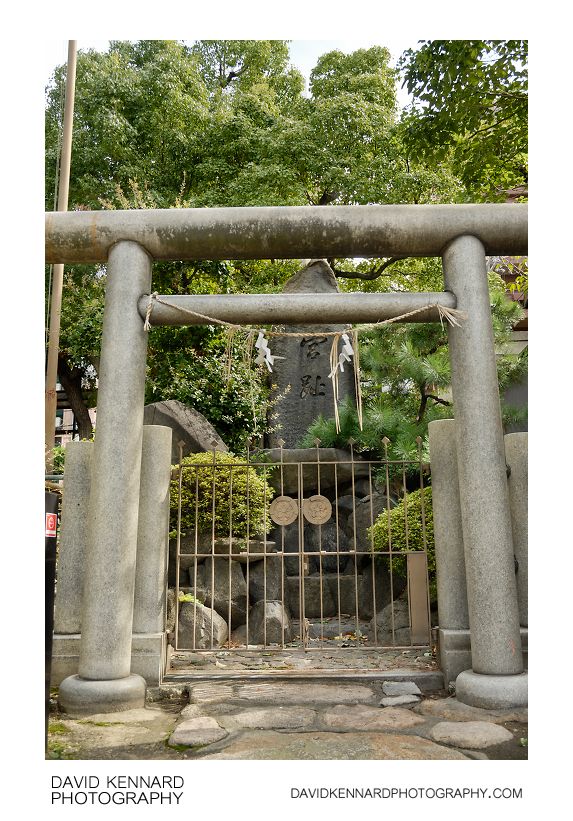Namba Yasaka Jinja - Miyashi rock and torii gate

Description
- Title:
- Namba Yasaka Jinja - Miyashi rock and torii gate
- Caption / Description:
-
A large rock beind a metal gate and stone torii gate at Namba Yasaka Shinto Shrine (難波八阪神社 Namba Yasaka Jinja) in Osaka city, Japan. The rock has the characters '宮趾' carved into it. The stone gate is of the simple shinmei torii (神明鳥居) type. Torii gates are used to mark the entrance to a sacred space.
From Wikipedia (http://en.wikipedia.org/wiki/Shinto):
Shinto (神道 Shintō) or Shintoism, also kami-no-michi, is the indigenous spirituality of Japan and the Japanese people. It is a set of practices, to be carried out diligently, to establish a connection between present day Japan and its ancient past. Shinto practices were first recorded and codified in the written historical records of the Kojiki and Nihon Shoki in the 7th and 8th century. Still, these earliest Japanese writings do not refer to a unified "Shinto religion", but rather to disorganized folklore, history, and mythology. Shinto today is a term that applies to public shrines suited to various purposes such as war memorials, harvest festivals, romance, and historical monuments, as well as various sectarian organizations. Practitioners express their diverse beliefs through a standard language and practice, adopting a similar style in dress and ritual, dating from around the time of the Nara and Heian Periods.
The word Shinto ("Way of the Gods") was adopted from the written Chinese (神道, shén dào), combining two kanji: "shin" (神), meaning kami; and "tō" (道), or "dō" meaning a philosophical path or study (originally from the Chinese word tao). Kami are defined in English as "spirits", "essences" or "deities", that are associated with many understood formats; in some cases being human-like, in others being animistic, and others being associated with more abstract "natural" forces in the world (mountains, rivers, lightning, wind, waves, trees, rocks). Kami and people are not separate; they exist within the same world and share its interrelated complexity.
There are currently 119 million official practitioners of Shinto in Japan, although a person who practices any manner of Shinto rituals may be so counted. The vast majority of Japanese people who take part in Shinto rituals also practice Buddhist ancestor worship. However, unlike many monotheistic religious practices, Shinto and Buddhism typically do not require professing faith to be a believer or a practitioner, and as such it is difficult to query for exact figures based on self-identification of belief within Japan. Due to the syncretic nature of Shinto and Buddhism, most "life" events are handled by Shinto and "death" or "afterlife" events are handled by Buddhism—for example, it is typical in Japan to register or celebrate a birth at a Shinto shrine, while funeral arrangements are generally dictated by Buddhist tradition—although the division is not exclusive.
- Tags / Keywords:
-
- Asia
- Shrine
- Rock
- Japan
- 日本国
- Nihon-koku
- Kansai region
- 関西地方
- Kansai-chihō
- Osaka prefecture
- 大阪府
- Ōsaka-fu
- Osaka city
- 大阪市
- Ōsaka-shi
- Naniwa-ku
- 浪速区
- 神社
- Jinja
- Kinki region
- 近畿地方
- Kinki-chihō
- Namba
- 難波
- Nanba
- Temple
- Namba Yasaka Shrine
- 難波八阪神社
- Shinto
- 神道
- 宮趾
- Shrine gate
- 鳥居
- Torii
- Stone torii gate
- Shinmei torii
- 神明鳥居
Admin
- Date Original Photo Taken:
- Original File Name:
- Stone torii and big rock.psd
- Event:
- Rating:
- ☆
- Date this image added/last updated on website:
- Original File Dimensions:
- 2584px x 3855px
- File Type:
- JPEG
- Color Mode:
- Original Image Color Profile:
- Nikon Adobe RGB 4.0.0.3001
Location
- Location Shown:
-
- Sublocation:
- Namba Yasaka Shrine
- City:
- Osaka
- Province/State:
- Osaka prefecture
- Country:
- Japan
- World Region:
- Asia
- Location Created:
-
- Sublocation:
- Namba Yasaka Shrine
- City:
- Osaka
- Province/State:
- Osaka prefecture
- Country:
- Japan
- World Region:
- Asia
- Geo-location:
- 34.661416666667, 135.4969 View on map
Rights
- Copyright Status:
- Copyrighted
- Licensing Status:
- Rights Managed
- Available for Editorial Use:
- Yes
- Available for Commercial Use:
- No
- Copyright Notice:
- © 2009 Dave Kennard
Camera Data
- Date Digital Resource was created:
- Shutter speed:
- 1⁄30 s
- Aperture:
- f/5.6
- Camera Model:
- Nikon D200
- ISO:
- 100
- Exposure Compensation:
- +1
- Focal Length:
- 24mm
- Focal Length (35mm equiv.):
- 36mm
- Metering Mode:
- Multi-segment
- Flash:
- No Flash
- Exposure Mode:
- Auto
- White Balance:
- Manual
- Light Source:
- Cloudy
- Exposure Program:
- Aperture-priority AE
Additional shooting metadata
- Lens:
- Nikon AF-S DX Zoom Nikkor ED 18-70mm F3.5-4.5G(IF)
- Filters used:
-
- B+W UV 010 MRC
- Additional Optics used:
- Setup:
- Handheld, bracketed ±1EV
Post Processing
- Image Modified:
- Software used:
-
- Nikon Capture NX 2
- Adobe Photoshop CS5
- Post Processing:
NEFs converted with -0.3 exposure compensation in CNX2
Images blended for exposure in PS CS5
Topaz Adjust using Photo Pop preset applied in PS CS5
